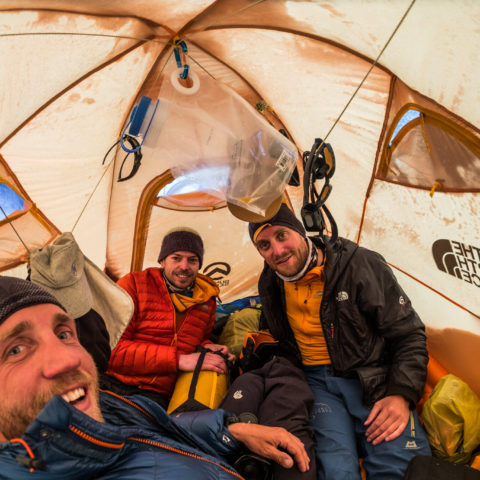
When we climbed Khan Tengri in 2017, we were very positive about our experience of pre-acclimatisation at home with an altitude tent from Altitude Dream. This allowed us to climb Khan Tengri in one go, without having to pass the icefall several times - the section with the most objective hazards of the route. How was our experience with the altitude tents this year?
I saw some differences between this year and 2017. My sleep program was the same, but because of my busy schedule, I had less time to do the passive and active acclimation with the mask. Passive acclimation means simply sitting down and using the mask at the highest setting (6,400 m) - 5 minutes on, 5 minutes off for an hour or more. Active means using the mask when exercising on an exercise bike, which is very intense. The other difference was the time between pre-acclimatization and arrival at base camp. In 2017, we were in base camp in a few days after our last night in the height tent, while this year lasted a week.
The first test of whether or not we had acclimatized was when we arrived at base camp at 4,000 m by helicopter. We felt pretty good! This was a good sign. Of course, you have to get used to doing everything at a slower pace and you definitely feel the lack of oxygen. But overall, we were fine - no headaches, good sleep, and good appetite. This meant that the hypoxic tents had done their job!
The real test came when we went from Khan Tengri C1 at 4,200m to C2 at 5,400m. This is a significant change in height. Acclimatization is very personal and is a very individual process. For example, I never have many problems at heights up to 5,500 m and can be quite fast, while Gijs / Martin seem to have many more problems around these heights. Above, however, it may be the opposite. I feel completely empty while they can continue, seemingly without much trouble. This happened on Khan Tengri. The journey to C2 was really easy for me. But after arrival I felt bad for a few days and I couldn't even reach C3, while Gijs and Marin felt fine and made two acclimatization trips to C3. This was very strange to me. In 2017 I was fine in C2 and had no problems, this year I really had a headache and was extremely slow when trying to get to C3.
As a combination of my slow acclimatisation and the bad weather, we could not follow our acclimatisation plan. We wanted to sleep at least one night at 6,400 m, but ended up sleeping only three nights at 5,400 m and then returned to BC, knowing that we would have to do a new acclimatisation rotation on Pobeda before making a summit attempt.
Our first acclimatization rotation at Pobeda was very tough. During this trip I felt much better and was able to make the first tracks for a significant part of the route to C2 at 5,200m through deep and heavy snow. Gijs and Martin were completely broken that day. But the days after, the roles had changed again, although I felt much better than on Khan Tengri. We eventually reached 6,300 m, without any of us having significant altitude problems. Our plan was to sleep at least 6,400 m, but preferably 7,000 m on this trip, but due to the heavy snow we had to descend.
Back in base camp, I wasn't sure if these two acclimatization rotations were enough for a summit attempt, where you normally sleep above 7,000m for three nights. But we didn't have a lot of choice and just went to see how we would feel. Unfortunately, during our summit attempt, we did not reach an altitude higher than 5,600 meters and we never found out.
This expedition was strategically difficult. How do you get enough acclimatization to sleep safely during the summit attempt for 3 nights above 7,000m? How can you not waste energy by always being first and making tracks through the deep snow? How to find a balance between the use of energy, the weather forecast, the amount of food (= weight) to take and the right acclimatization? Is it better to stay high for a longer period of time knowing this will deplete your energy or better to descend sooner instead to take a rest in BC? Finding the best strategy was a major challenge this year, as this was a daily topic of discussion in the group.
Did the pre-acclimatization work? Absolutely! However, I noticed that my body reacted differently this year than it did two years ago. I believe my pre-acclimation was less than in 2017 as I made less effort for the active and passive hypoxic training. Would I use this strategy again next time? Depends - if I have time to acclimatize in the Alps or on a real mountain, this is of course always more fun. But if I don't have this option, I definitely would!







